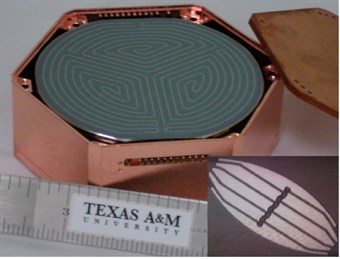 Dr. Rusty Harris, assistant professor in the Department of Electrical and Computer Engineering at Texas A&M University, recently joined the Cryogenic Dark Matter Search (CDMS) collaboration in announcing a new threshold of dark matter detection with extremely improved background rejection capabilities.
Dr. Rusty Harris, assistant professor in the Department of Electrical and Computer Engineering at Texas A&M University, recently joined the Cryogenic Dark Matter Search (CDMS) collaboration in announcing a new threshold of dark matter detection with extremely improved background rejection capabilities.
Dark matter is the nearly unseen material that is hypothesized to not interact with matter that we observe through normal means (e.g. electromagnetic or nuclear forces), but is present in such large quantities that it has a significant impact on gravitational observation in the universe.
An intense search has been underway for nearly 20 years to validate the hypothesis, and it is considered one of the most urgent unanswered questions in physics.
 CDMS scientists, including Harris, who holds a joint appointment in the physics department, along with Drs. Rupak Mahapatra and David Tobak in physics, make detectors out of large masses of ultra-high purity Ge and Si. Statistically, as dark matter passes through the Earth, it interacts with mass to a small extent.
CDMS scientists, including Harris, who holds a joint appointment in the physics department, along with Drs. Rupak Mahapatra and David Tobak in physics, make detectors out of large masses of ultra-high purity Ge and Si. Statistically, as dark matter passes through the Earth, it interacts with mass to a small extent.
When buried deep underground (to block cosmic background radiation) and cooled to very low temperatures, the collision of dark matter particles with the Ge/Si detectors releases heat and charge that can be detected when that temperature is below 100 milliKelvin (very close to absolute zero).
Comparison of the amount of charge and heat released can distinguish whether the collision event was a result of a known high energy particle/photon or that of a Weakly Interacting Massive Particle (WIMP) as dark matter is commonly called.
This research was partly made possible using nanotechnology and materials processing research common in nanotechnology manufacturing. The charge and heat detectors have to be formed on the surface of the Ge/Si detectors, and Harris’ application of process control and in situ materials characterization techniques has improved reliability and interpretability of data collected in the CDMS collaboration.
The announcement shifts the border of the WIMP search down to a dark-matter particle mass and rate of interaction that has never been probed. Previous collider experiments have all but eliminated potential mass greater than 20 GeV/c2 (the common expression for particle mass derived from Einstein’s famous E=mc2 equation). The increased interest in low-mass dark matter is challenging: the lower the mass of the dark-matter particles, the less energy they leave in detectors, and the more likely it is that background noise will drown out the WIMP signals. The work of CDMS and the Texas A&M collaborators has demonstrated the capability to probe below 6 GeV/c2 with excellent background rejection.
Harris joined the department in 2008 from Advance Micro Devices (AMD). His expertise is in complex integration of nano systems, wide band gap materials, high voltage and high frequency devices and process integration. He is author and co-author of more than 70 peer-reviewed journal papers, conference proceedings and invited talks. In addition to his joint appointment in physics, he holds a courtesy appointment in The Department of Materials Science and Engineering. Expansion of the research into low temperature semiconductors and superconductors is a natural progress as it applies to the CDMS research since Harris has extensive process and materials experience with Ge and Si.
The collaboration has detailed its latest results in a paper published in ArXiv (http://arxiv.org/abs/1402.7137). Their work is funded by the Department of Energy (DOE) and the National Science Foundation (NSF) as well as the Natural Sciences and Engineering Research Council of Canada (NSERC).
For more information on the CDMS Experiment, go to http://cdms.berkeley.edu/.
To learn more about Texas A&M's involvement with the collaboration and related research, visit http://faculty.physics.tamu.edu/mahapatra/